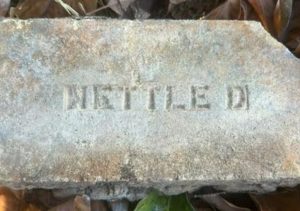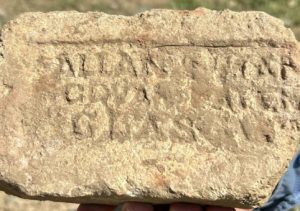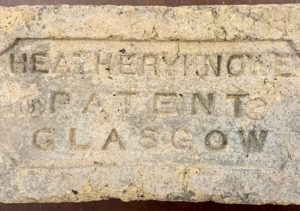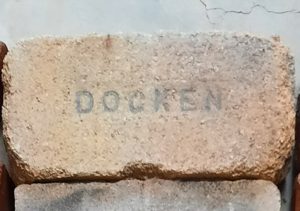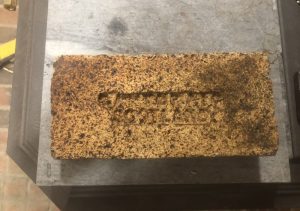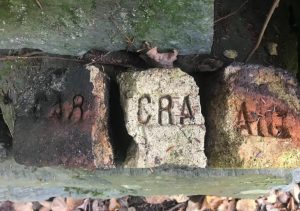14/07/1923 – Glasgow Herald – Man was not long on the world’s stage when he commenced to work clay and impress on its plastic surface his primitive ideas. A common clay brick, even to the initiated tells its story and forms an important clue in the history of man. In Scotland, the earliest bricks made by man were hardened by the sun (Note – SBH – Do we have archaeological evidence of this?) but as he became more civilised he required a more durable article, so fire was added to the process of hardening. This made it essential for claypits to be in close proximity to coalfields for economical production. The extensive beds of good clay in and around Glasgow have this advantage.
We have in the West End a small street called Clayslaps running from Argyle Street to Sauchiehall Street which, if followed, would lead us to the banks of the Kelvin, where a few years ago a mill dam was to be seen – an old brickwork was in operation here some 70 years ago. Moving north and eastwards we arrive at North Woodside Road and Napier Street where in the middle of the 19th century a claypit was worked by two men, Murray and Stewart, until it was ultimately closed owing to the encroachment of dwelling houses. In many instances, clay pits were not exhausted by the brickmaker before the builder came on the scene and drove him off to distant fields. The south side of Sauchiehall Street provides excellent brick clay whenever any excavations are made. But the chief clay pits were in the Calton. The clay field is clearly defined and lies to the east and north from Glasgow Cross through what was once Calton Open and on to Parkhead. It was a veritable ‘Potters’ field. We have Clayknowes, Claythorne, Tilefield, Wesleyan, Williamson and Cubie Streets and Clayton Place, all reminiscent of these old clay pits. In the olden days, this part of the city was the Gallows Muir, where condemned men were wont to be hanged. Gallowgate now runs directly through the Muir. It was a dreary, desolate waste piece of ground owing to its cold clayey soil.
One of the earliest records of a claypit here is dated 1663, wherein James Colquhon (Colquhoun?) “craves permission from the Corporation of Glasgow to open a claypit”. Later in 1722, William Maxwell, another brickmaker, makes a similar request to start work near the ‘Pig – Hoos’. This was the brick and clay worker’s howff or pub. ‘Pig’ meaning pottery such as we will speak of with regard to a ‘pig’ in the bed when we mean a hot water bottle. Another clay pit near the old public house was the Kingfield, the site of which may be described by the present landmarks as having been situated at the corner of Anderston and Chalmers Streets, Calton. (Note – SBH – Could William Cahoone be related to James Colquhon?).
The largest brickmaker of the 18th century was John Anderson who died in 1811 and lies buried in the Cathedral Churchyard. He owned a claypit of two acres but this was insufficient for his rapidly increasing trade and he leased over five acres from the authorities of the old University, then situated in High Street. The site of this extensive clayfield is indicated in a map of the time as being east of Harrack Street. By 1825 this claypit reached the zenith of its prosperity. The city was then extending rapidly and people were flowing in from rural parts of Scotland to find employment in the new factories and cotton mills then springing up around. Dwelling houses had to be provided for them and brickworks flourished. Many of these houses, especially Bridgeton way, were erected of brick, roofed with red tiling and even the chimneys were finished off with red lums made from Calton Clays.
The industry received a severe shock in 1750 (Note – SBH – I am not sure this date is correct – will need to do some research?) when the government, being hard-pressed for money due to their depleted exchequer, taxed bricks at ? shillings per thousand. (Note SBH – This whole sentence is difficult to read from the copy I have seen). This made bricks dearer than the abundant local sandstone. It has been stated that but for the incidence of this tax, Glasgow might have been a brick-built city, like some of her English sisters. In many parts of old Glasgow many of these brick houses, with their quaint roofs and chimneys, are still to be seen especially in Calton.
In spite of the tax, John Anderson tells us he was able to ship his roofing tiles to our colonies, Virginia and Carolina in America.
Germiston was another famous claypit over a hundred years ago. Duke Street Prison was erected on the site of a claypit owned by a man Pettigrew (Pittigrew?). The pits of Claythorne and Clayknowes were worked by one John Johnstone for many years.
In 1797 the Wellington claypits were opened by the Williamsons who were joined latterly by Adam Cubie. These people were of the Wesleyan persuasion and for this reason, Wesleyan Street, which covers part of the pit, received its title. The place was ultimately compelled to close owing to the demands for building sites in the vicinity. Williamson and Cubie Streets cover the site of the brickworks. The office of the works was 601 Gallowgate. I should say there is hardly a garden in Scotland that does not have some flower pots made from this Wellington claypit. Further east we have the various large claypits in Camlachie.
On the South-Side, there were the Shawfield claypits which at one time belonged to Sheriff Allison. These with Polmadie claypits are of a very ancient origin. There is a record dated 1595 of a brickwork being worked at Blackfaulds which is adjacent to these clayfields. Near the Gorbals Kirk was a small brick and tile work occupied by one John Holden. He carried on his business successfully until April 28th (23rd?) 1781, when according to a Glasgow journal of that date, it was put up for sale by public auction. These South-Side claypits have almost completely vanished and the ground levelled for other purposes.
Formerly clay bricks were only made by hand but machinery was ultimately and successfully introduced. At the height of their prosperity, as many as 40,000,000 bricks were made in Glasgow and its neighbourhood annually. They were of excellent quality as can be judged from the buildings that were erected with them. The clay, when well burned, is exceptionally strong and solid. The bricks were largely used in the erection of factory chimneys and were excellently adapted for that purpose being well able to carry any weight that may be placed upon them.
An article on clay and bricks could not finish without some reference to the huge bings of ‘blaise’ that disfigured for many years the north side of the Great Western Road opposite the boating pond. They were a disfigurement of the landscape 40 years ago. Fortunately, an interesting discovery was made that these ‘blaise’ heaps that had accumulated by the surrounding old ironstone pits, could be turned profitably into good brick. The material is not plastic like clay. It is first crushed into a powder, then it is mixed in iron moulds and the brick is formed under considerable pressure after which it is fired in a continuous kiln. These’composition’ bricks are cheap and are extensively used for gable walls, partitions etc. We cannot fail to notice the slow but steady disappearance of these black hillocks that were once so familiar landmarks in the surrounding landscape.
Ferro-concrete erections are now replacing the older brick and these reflections recall to our mind the days when our city was of comparatively limited bounds when we consider that some of the clay pits mentioned are well within our city boundaries. J. Arnold Fleming.

